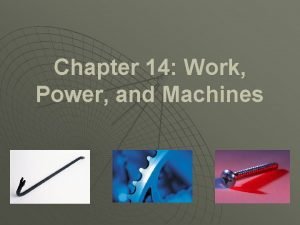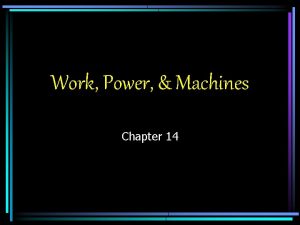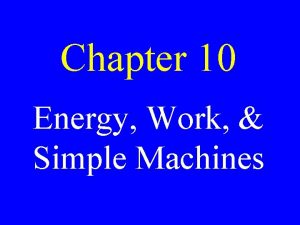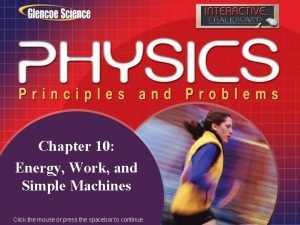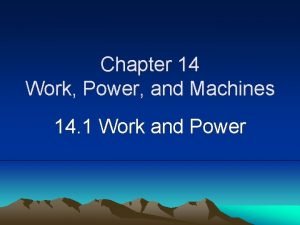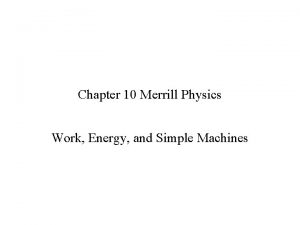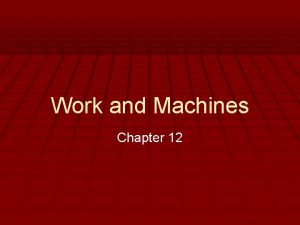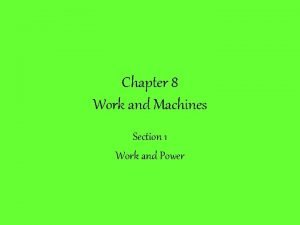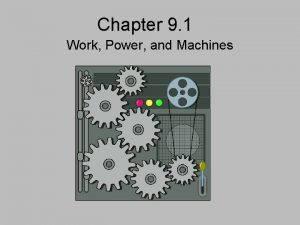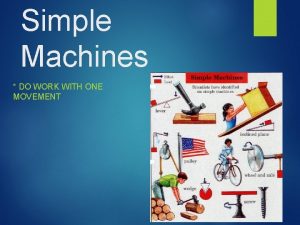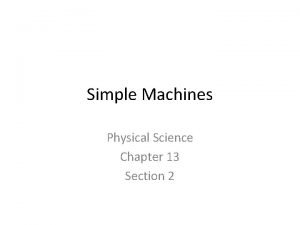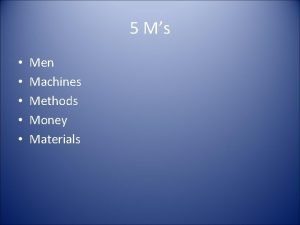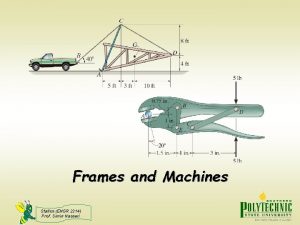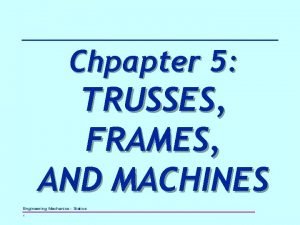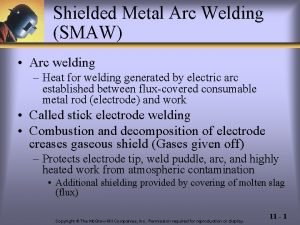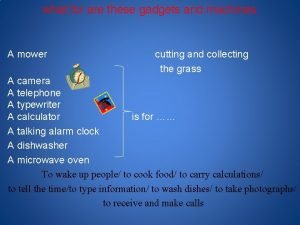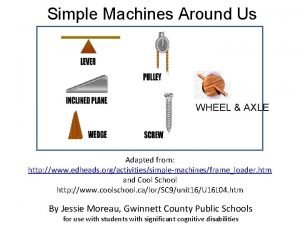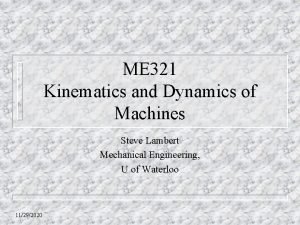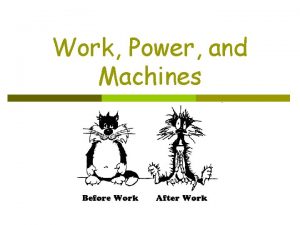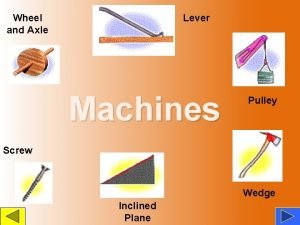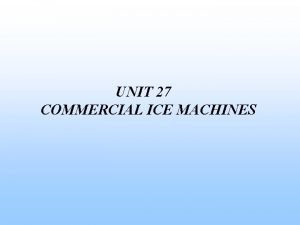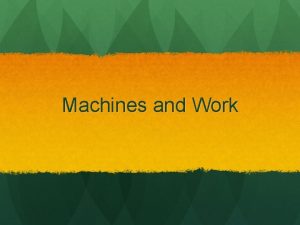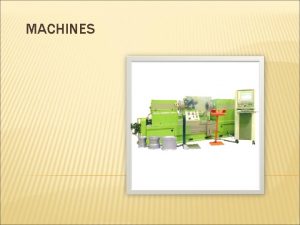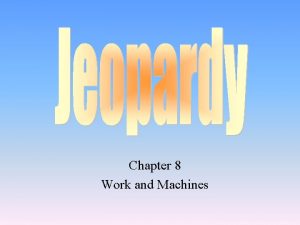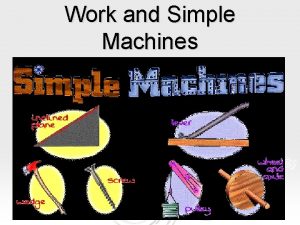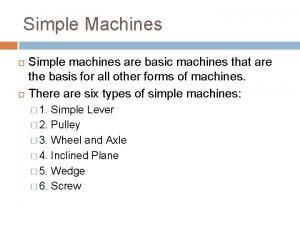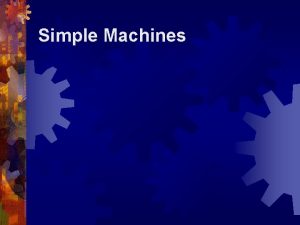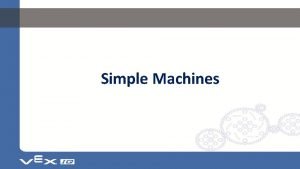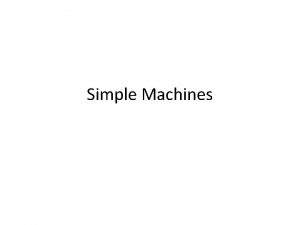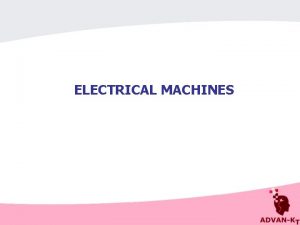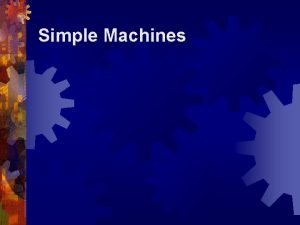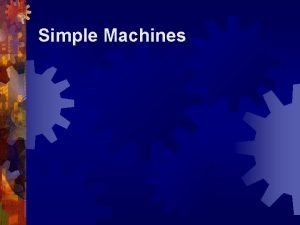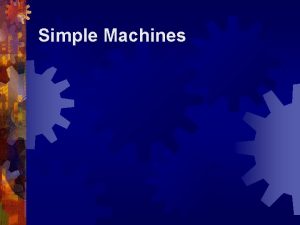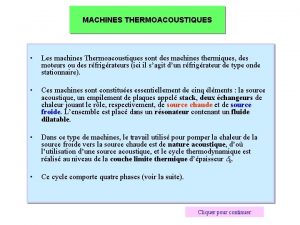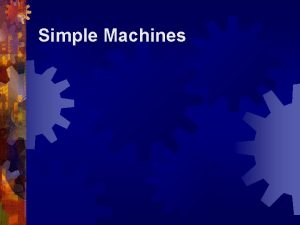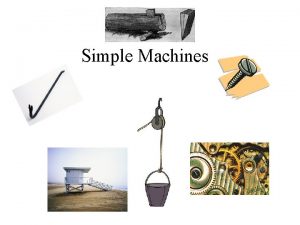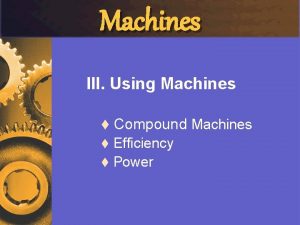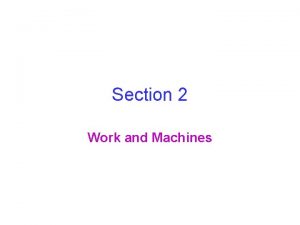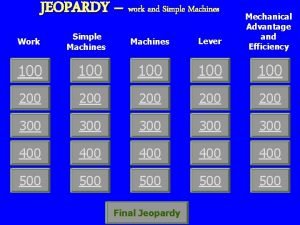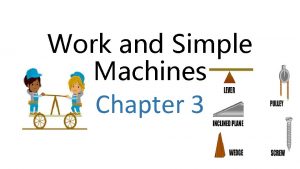Work and Machines Chapter 12 What Is Work





































- Slides: 37

Work and Machines Chapter 12

- What Is Work? 12. 1 What is Work? § Work is done on an object when the object moves in the same direction in which the force is exerted.

§ WORK = Force x Distance § JOULE = N x M § POWER -power equals the amount of work done on an object in a unit of time POWER = Work (Watt) Time 1 W = 1 J/s or Force x Distance Time 1000 W = 1 k. W

- What Is Work? Calculating Power § A tow truck exerts a force of 11, 000 N to pull a car out of a ditch. It moves the car a distance of 5 m in 25 seconds. What is the power of the tow truck? § What information have you been given? § Force of the tow truck (F) = 11, 000 N § Distance (d) = 5. 0 m § Time (t) = 25 s

- What Is Work? Calculating Power §A tow truck exerts a force of 11, 000 N to pull a car out of a ditch. It moves the car a distance of 5 m in 25 seconds. What is the power of the tow truck? §What quantity are you trying to calculate? § The Power (P) the tow truck uses to pull the car = __ §What formula contains the given quantities and the unknown quantity? § Power = (Force X Distance)/Time §Perform the calculation. § Power = (11, 000 N X 5. 0 m)/25 s § Power = (55, 000 N • m)/25 s or 55, 000 J/25 s § Power = 2, 200 J/s = 2, 200 W

- What Is Work? Calculating Power § A tow truck exerts a force of 11, 000 N to pull a car out of a ditch. It moves the car a distance of 5 m in 25 seconds. What is the power of the tow truck? § Does your answer make sense? § The answer tells you that the tow truck used 2, 200 W to pull the car. This value is about the same power that three horses would exert, so the answer is reasonable.

- What Is Work? Calculating Power § Practice Problem § A motor exerts a force of 12, 000 N to lift an elevator 8. 0 m in 6. 0 seconds. What is the power produced by the motor? § 16, 000 W or 16 k. W

- What Is Work? Calculating Power § Practice Problem § A crane lifts an 8, 000 -N beam 75 m to the top of a building in 30 seconds. What is the crane’s power? § 20, 000 W or 20 k. W

12. 2 How machines do work § A machine makes work easier by changing one of at least three things: -the amount of force -the distance over which the force is exerted -the direction of the force Input Force x Input Distance = Input Work Output Force x Output Distance = Output Work Mechanical Advantage = Output Force Input Force

§ The amount of input work done by the gardener equals the amount of output work done by the shovel.

§ In every machine, some work is wasted while overcoming the force of friction. Efficiency = Output Work X 100% Input Work

- How Machines Do Work What Is a Machine? § A machine makes work easier by changing at least one of three factors. A machine may change the amount of force you exert, the distance over which you exert your force, or the direction in which you exert your force.

- How Machines Do Work Mechanical Advantage §The input force and output force for three different ramps are shown in the graph.

- How Machines Do Work Mechanical Advantage § Reading Graphs: § What variable is plotted on the horizontal axis? §Input force

- How Machines Do Work Mechanical Advantage § Interpreting Data: § If an 80 -N input force is exerted on Ramp 2, what is the output force? § 400 N

- How Machines Do Work Mechanical Advantage § Interpreting Data: § Find the slope of the line for each ramp. §Ramp 1: 10; Ramp 2: 5; Ramp 3: 2

- How Machines Do Work Mechanical Advantage § Why does the slope represent each ramp’s mechanical advantage? Which ramp has the greatest mechanical advantage? §The slope of each ramp’s graph equals the change in output force divided by the change in input force. This is the formula for mechanical advantage. Ramp 1 has the greatest mechanical advantage.

- How Machines Do Work Calculating Efficiency § You do 250, 000 J of work to cut a lawn with a hand mower. If the work done by the mower is 200, 000 J, what is the efficiency of the lawn mower? § What information have you been given? § Input Work (Winput) = 250, 000 J § Output Work (Woutput) = 200, 000 J

§You do 250, 000 J of work to cut a lawn with a hand mower. If the work done by the mower is 200, 000 J, what is the efficiency of the lawn mower? §Plan and Solve §What quantity are you trying to calculate? § The efficiency of the lawn mower = __ §What formula contains the given quantities and the unknown quantity? § Efficiency = Output work/Input work X 100% §Perform the calculation. § Efficiency = 200, 000 J/250, 000 J X 100% § Efficiency = 0. 8 X 100% = 80% §The efficiency of the lawn mower is 80 percent.

- How Machines Do Work Calculating Efficiency § You do 250, 000 J of work to cut a lawn with a hand mower. If the work done by the mower is 200, 000 J, what is the efficiency of the lawn mower? § Does your answer make sense? § An efficiency of 80 percent means that 80 out of every 100 J of work went into cutting the lawn. This answer makes sense because most of the input work is converted to output work.

- How Machines Do Work Calculating Efficiency § You do 20 J of work while using a hammer. The hammer does 18 J of work on a nail. What is the efficiency of the hammer? § 90%

- How Machines Do Work Calculating Efficiency § Suppose you left your lawn mower outdoors all winter. Now it’s rusty. Of your 250, 000 J of work, only 100, 000 J go to cutting the lawn. What is the efficiency of the lawn mower now? § 40%

§ Changing Force § Small input force X large input distance = large output force X small output distance examples: using a ramp, faucet knob § Changing Distance § Large input force X small input distance = small output force X large output distance example: hockey stick, chopsticks, bicycle § Changing Direction § small input force X large input distance = large output distance X small output force examples: weight machine , pulley

Simple Machines 12. 3 § A machine helps you do work by changing the amount or direction of the force you apply. § Inclined Plane § Allows you to exert your input force over a longer distance § M. A. = length of inclined plane height of inclined plane § Wedge § § § Moving inclined plane Longer and thinner the wedge = ↑ M. A. = length of wedge width of wedge

- Simple Machines Inclined Plane § An inclined plane is a flat, sloped surface.

- Simple Machines Wedge § A wedge is a device that is thick at one end and tapers to a thin edge at the other end.

§ Screws § The threads of the screw increase the distance § The closer the threads are to each other = ↑ M. A. § M. A. = length around the threads length of the screw § Levers § M. A. = distance from fulcrum to input force distance from fulcrum to output force 1 st class levers - change the direction of input force ex. Paint can opener, pliers, & seesaws 2 nd class levers - increase force w/out changing direction of input force ex. Doors, nutcrackers, & bottle openers 3 rd class levers - increase distance w/out changing the direction of input force ex. Fishing poles, shovels, baseball bats

- Simple Machines Screws § A screw can be thought of as an inclined plane wrapped around a cylinder.

- Simple Machines Levers § A lever is a ridged bar that is free to pivot, or rotate, on a fixed point.

- Simple Machines Levers § Levers are classified according to the location of the fulcrum relative to the input and output forces.

§ Wheel & Axle § Screw driver, doorknob, steering wheel § M. A. = radius of wheel radius of axle § Pulley § M. A. = # of sections of rope Fixed Pulley - changes the direction of force but not the amount of force Movable Pulley - decreases amount of input force needed but does not change the direction of the force

- Simple Machines Wheel and Axle § A wheel and axle is a simple machine made of two circular or cylindrical objects fastened together that rotate about a common axis.

- Simple Machines Wheel and Axle § You can find the ideal mechanical advantage of a wheel and axle by dividing the radius of the wheel by the radius of the axle.

- Simple Machines Pulley § A pulley is a simple machine made of a grooved wheel with a rope or cable wrapped around it.

- Simple Machines Types of Pulleys Activity § Click the Active Art button to open a browser window and access Active Art about types of pulleys.

- Simple Machines in the Body § Most of the machines in your body are levers that consist of bones and muscles.

- Simple Machines Compound Machines § A compound machine is a machine that utilizes two or more simple machines.
 Section 4 review physical science
Section 4 review physical science Chapter 14 work power and machines
Chapter 14 work power and machines Energy work and simple machines chapter 10 answers
Energy work and simple machines chapter 10 answers Chapter 14 work power and machines
Chapter 14 work power and machines Chapter 10 energy, work and simple machines answer key
Chapter 10 energy, work and simple machines answer key Energy work and simple machines chapter 10 answers
Energy work and simple machines chapter 10 answers Chapter 14 work power and machines
Chapter 14 work power and machines Chapter 10 work energy and machines
Chapter 10 work energy and machines The force you exert on a machine
The force you exert on a machine Section 1 work and machines
Section 1 work and machines Section 2 describing energy (continued)
Section 2 describing energy (continued) Work power energy and machines
Work power energy and machines A crate of bananas weighing 3000 n
A crate of bananas weighing 3000 n How do machines make work easier
How do machines make work easier A machine that does work with only one movement
A machine that does work with only one movement What kind of simple machine is a boat oar
What kind of simple machine is a boat oar Man material machine method money
Man material machine method money Neural networks and learning machines 3rd edition
Neural networks and learning machines 3rd edition Frames and machines statics example problems
Frames and machines statics example problems What is truss in mechanics
What is truss in mechanics Dr. dudley sargent invented 80 machines, using
Dr. dudley sargent invented 80 machines, using Les machines simple
Les machines simple Mechanical drives and lifting machines n2
Mechanical drives and lifting machines n2 Arc length welding definition
Arc length welding definition What is a wheel and axle? *
What is a wheel and axle? * Machines and gadgets
Machines and gadgets Wheel and axle examples around the house
Wheel and axle examples around the house Kinematics and dynamics of machines
Kinematics and dynamics of machines Tool and tackles
Tool and tackles Neural networks and learning machines
Neural networks and learning machines Hard work vs smart work
Hard work vs smart work Physics 03-01 work and the work-energy theorem
Physics 03-01 work and the work-energy theorem Find the efficiency of a machine that does 800 j
Find the efficiency of a machine that does 800 j Example of a wheel and axle
Example of a wheel and axle Define a slogan
Define a slogan Examples of wedge
Examples of wedge Vending machine disadvantages
Vending machine disadvantages Icesea ice maker
Icesea ice maker

